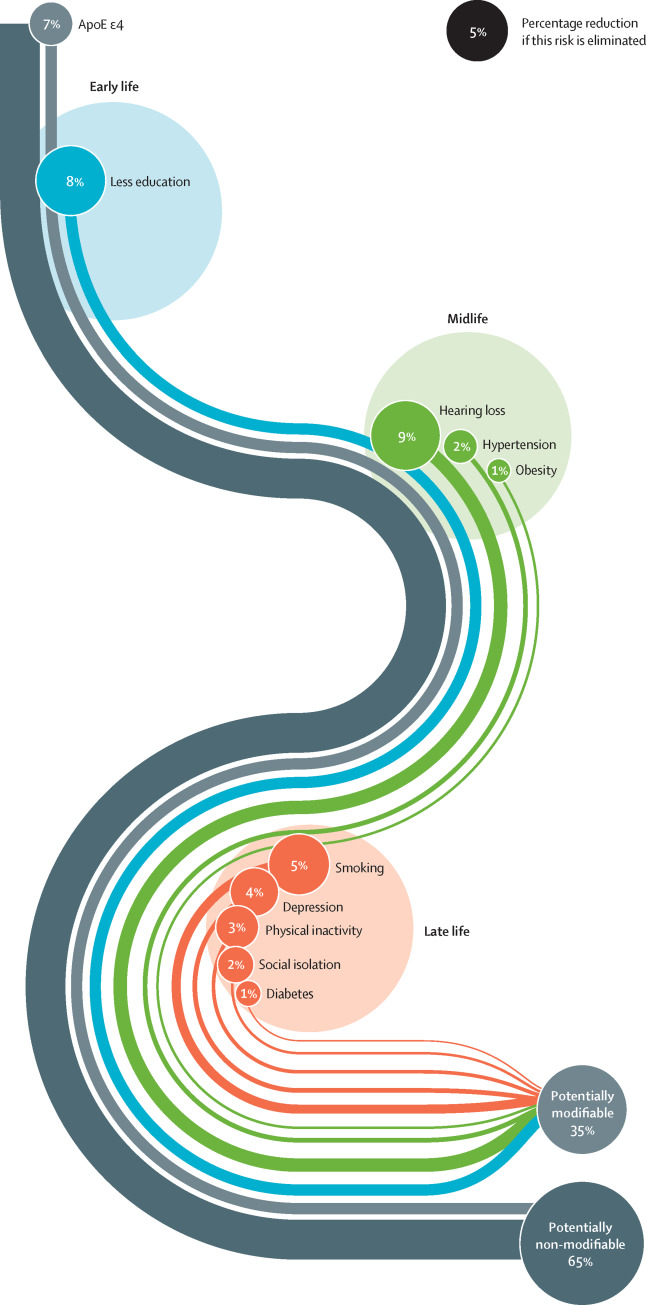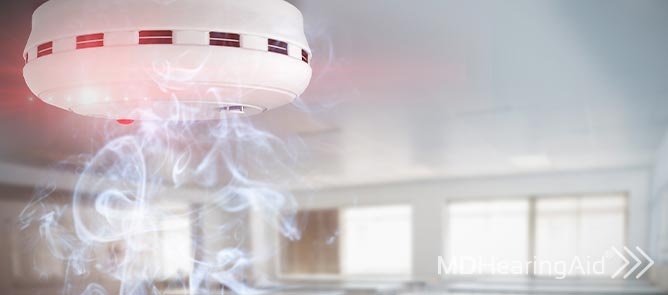According to the President’s Council of Advisors on Science and Technology (PCAST), half of Americans over the age of 60 suffer from some level of hearing loss. Also, with the older population growing, PCAST estimates that the number of Americans with hearing loss will soar to 82 million by 2040.
This figure is nothing short of frightening when you consider the many health consequences and financial dangers of hearing loss. In this article, we’ll review these dangers in detail – and hopefully, you will be inspired to seek medical attention at the first sign of hearing decline.
1. Alzheimer’s, Dementia, and Cognitive Decline
Research from the National Institute on Aging and John Hopkins University followed the medical condition, level of hearing loss, and cognitive ability of 2,000 adults with an average age of 77 years. Compared to the individuals with normal hearing, those with hearing loss showed a 24% greater chance of cognitive decline. In these cases, the cognitive deficiencies were so severe that they interfered with the patients’ conversation abilities.
John Hopkins Medicine wrote the following about the study:
“Compared with volunteers with normal hearing, those with mild, moderate, and severe hearing loss had twofold, threefold, and fivefold, respectively, the risk of developing dementia over time. The more hearing loss they had, the higher their likelihood of developing the memory-robbing disease.”
Image Source: thelancet.com
Fortunately, hearing impairment is the strongest modifiable risk factor for cognitive decline. A 2015 study published by JAMA suggests that medical treatments for hearing loss may be able to correct the cognitive problems in many hearing loss patients. The study showed that 80% of people with low cognitive scores significantly improved their cognitive abilities a year after receiving a cochlear implant.
A cochlear implant stimulates the auditory nerve in the inner ear, and it can help certain individuals overcome hearing loss and deafness challenges. The positive findings – of the 2015 study on cochlear implants and cognitive improvements – open the door for further study to see if similar results are possible with normal hearing aids.
Whether hearing aids can help prevent dementia or not, early detection of hearing loss through regular screening can play a key role in determining an individual’s risk-level for dementia. It also ensures that hearing loss treatment can begin before the hearing loss starts affecting other areas of a person’s health and well-being. The American Speech-Language-Hearing Association (ASHA) recommends that you screen for hearing loss once every 10 years until the age of 50. After that, you should screen every three years. MDHearing offers a free online hearing test you can take from any computer.
2. Loss of Speech Comprehension
A specific area of cognitive decline connected to hearing loss is the loss of speech comprehension. Loss of speech comprehension often relates to two factors: (1) the ear’s inability to hear speech sounds clearly; and (2) the brain’s declining ability to process and comprehend speech sounds due to a lack of “exercising” the capacity.
Many researchers agree that the concept of “use-it-or-lose-it” applies to the loss of speech comprehension skills. Researchers theorize that the less we can hear, the less we exercise the areas of the brain required to understand speech. Eventually, this lack of stimulation weakens the brain’s speech processing and comprehension capabilities.
Fortunately, there are two ways you can exercise and improve speech comprehension at the brain level:
- Speech comprehension brain exercises: A special smartphone app from Lace Listening offers a variety of exercises that build your ability to comprehend speech in noise. According to the app developer, exercising with the technology on a regular basis may improve your speech comprehension in sound by as much as 30%.
- Hearing aids: Treating hearing loss with hearing aids as early as possible is an extremely important corrective measure that will strengthen your brain’s ability to understand speech. By maintaining a continual stream of speech stimulation to your brain, you’ll keep your speech comprehension skills as strong as possible.
If you find yourself asking “What?” and “Pardon me?” throughout the day, you could be experiencing early signs of hearing loss. The sooner you address the issue, the sooner you can correct any associated speech comprehension loss.
3. Fire Alarms and Warning Signals
Our safety often depends on the ability to hear alarms, alerts, and other signals of danger. However, many of these alarms – especially smoke alarms – emit pure tone signals tuned within the 3000 to 4000 Hz range. This frequency range is extremely difficult for people with hearing loss to hear.
According to researcher Dr. Dorothy Buck, “Lots of people over 60 have high-frequency hearing loss… Those sorts of things put people at risk. There is a reduced chance that you will wake up to the current high-pitched smoke alarm.” For this reason, Dr. Buck recommends that alarm manufacturers use frequencies that are likely to wake up people with hearing loss.
In the meantime, those with hearing loss should invest in a hearing-impaired fire alarm. These alarms usually emit a lower tone that’s easier to hear, and some emit a bright flashing light to alert individuals with severe hearing loss. Loudenlow and Lifetone are two manufacturers that sell fire alarms designed for people with hearing loss.
But what about the alarms and signals you hear while awake? Here are some of the most important “sounds of danger” that could save your life if you’re able to hear them:
- Fire and smoke alarms
- Ambulance and police sirens on the road
- Windows breaking during a burglary
- Home and car burglar alarms
- A telephone call from a loved one in trouble
- The sounds of traffic while walking
- A forklift passing by in a department store
To make sure you hear these sounds and you’re aware of what’s happening around you, an affordable hearing aid from MDHearing can provide life-saving support.
4. Falling Dangers
The greater your hearing loss, the more likely you are to fall and get hurt. According to a 2012 John Hopkins study, only 25-decibels of mild hearing loss will triple your chances of falling. For every 10 decibels of hearing loss over that, the risk of falling increases by 140%.
Why do people with hearing loss have a greater risk of falling? The author of the study, Dr. Frank Lin, believes that reduced hearing puts additional demands on our brains, and this leads to cognitive overload, which interferes with balance:
“Gait and balance are things most people take for granted, but they are actually very cognitively demanding. If hearing loss imposes a cognitive load, there may be fewer cognitive resources to help with maintaining balance and gait.”
The danger of falling is particularly scary when you consider the health and financial costs. Falling causes 55% of deaths in the United States each year, and approximately $50 billion in damages according to the U.S. Centers for Disease Control and Prevention.
Hearing aids offer an excellent solution to minimize the risk of falling. A Washington University study reported that hearing aids in both ears offered a considerable improvement in balance and reduced risk of falling when they were turned on versus when they were turned off.
Here’s what researchers found in their tests:
- Foam pad test: Patients maintained their balance for approximately 17 seconds when hearing aids were off. They maintained their balance for approximately 26 seconds when hearing aids were on.
- Heal-to-toe test: Patients maintained their balance for approximately 5 seconds when hearing aids were off. They maintained their balance for approximately 10 seconds when hearing aids were on.
The author of the Washington University study, Dr. Timothy E. Hullar, believes that hearing aids help because sound information is an integral part of balance:
“We don’t think it’s just that wearing hearing aids makes the person more alert. The participants appeared to be using the sound information coming through their hearing aids as auditory reference points or landmarks to help maintain balance. It’s a bit like using your eyes to tell where you are in space. If we turn out the lights, people sway a little bit — more than they would if they could see. This study suggests that opening your ears also gives you information about balance.”
5. Depression
Depression is another health danger that goes hand-in-hand with hearing loss. A 2014 report published by the National Institute on Deafness and Other Communication Disorders (NIDCD) indicates that adults with hearing loss are almost twice as likely to suffer from depression:
“The prevalence of moderate to severe depression was higher among U.S. adults aged 18 or older with self-reported hearing impairment (11.4 percent) compared to those without hearing impairment (5.9 percent).”
Another study by The Gerontologist corroborates the results:
“Compared to people without hearing loss, older adults with some form of hearing loss were 47 percent more likely to have symptoms of depression.”
The apparent correlation between depression and hearing loss suggests how important it is to treat hearing loss as soon as possible. From a quality of life perspective, corrective hearing aids could dramatically improve an individual’s psychological welfare and happiness.
6. Lower Incomes
Loss of income is another danger of hearing loss that cannot be ignored. A 2015 study by Drs. Susan D. Emmett and Howard W. Francis showed a correlation between hearing loss and lower income. Even though researchers controlled the results of this study to account for variables like gender, age, race, and education, the results still showed a direct relationship between hearing loss and economic hardship.
Compared to those with normal hearing, the study found that adults with hearing loss (ages 20 to 69) have higher chances of:
- Low income: 1.58 times higher chance
- Unemployment or underemployment: 1.98 times higher chance
- Low education attainment: 3.21 times higher chance
Additional research from the National Council on Aging revealed just how severe the income disparity can get for patients with untreated hearing loss. Dr. Mark Rosshat, an audiologist/researcher from Gallaudet University, summarised the results of the study as follows:
For the group with the most severe hearing losses (10 percent of the total), the income differential between the aided and unaided groups reaches the rather astounding figure of $31,000 a year! This is how much less people with the most severe, unaided hearing loss make compared to a comparable group of hearing aid users. This is clearly a horrendous and discouraging figure …
In this, as in so many other areas concerning hearing loss, passivity is not an option. But the first step, as this article by Kochkin demonstrates, is for the person with a hearing loss to acquire and use hearing aids.
Prevent the Dangers of Hearing Loss with MDHearing
After reading this article, you should have a clear understanding of the many dangers associated with hearing loss. Considering the serious consequences of hearing loss – like cognitive decline, Alzheimer’s, depression, falling, and lower earning capacity – investing in a set of hearing aids could be one of the best decisions you make to safeguard your health and financial security in the years ahead.
At MDHearing, we offer a wide range of affordable, high-quality, FDA-registered hearing aids that fit 80% of hearing loss conditions. You can purchase our medical-grade hearing aids from the privacy of your home without visiting a doctor or audiologist. Best of all, if our hearing aids aren’t the right match for your needs, you can return them with our 100% money-back satisfaction guarantee. Rather than charge the nearly $5,000 for a pair of hearing aids that traditional clinics do, or the nearly $3,000 that other direct sellers like Eargo do, we charge between $399 per pair and $999 per pair. Check out our comparison page to compare hearing aid options.
Have you noticed any signs of hearing decline? Take our quick and easy online hearing test and get your results instantly.
TAKE ONLINE HEARING TEST




